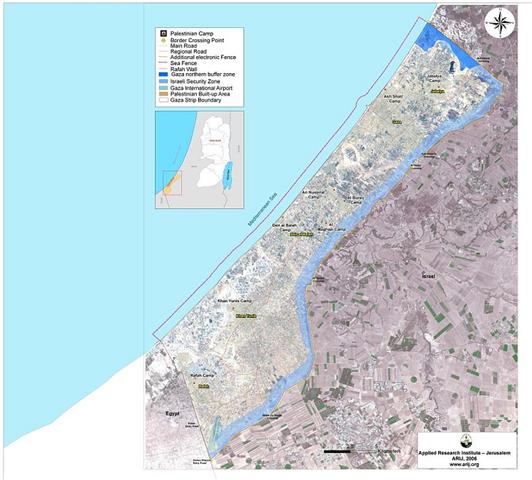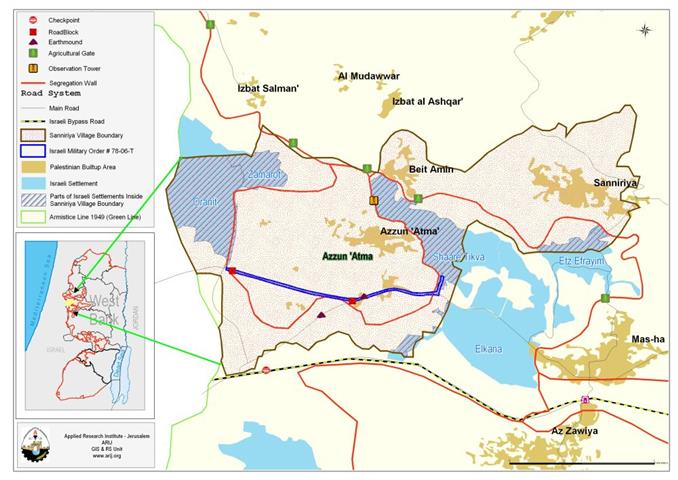The Gaza strip is once again facing a prolonged period of closure, which is crippling the economy, and contributing to the unbearable day-to-day living conditions within the strip. On Wednesday the 30th of August Kofi Annan – the UN secretary general – highlighted this in a joint press conference with Palestinian President Abbas in which he called for the re-opening of Gazas crossings [including the Rafah border crossing with Egypt and the main crossings to Israel to connect Gaza with the West Bank] in order to 'sustain life' in the strip. (Al-Jazera net).
'Beyond preserving life, we have to sustain life. The closure of Gaza must be lifted [and] the crossing points must be opened, not just to allow the import of goods but to allow Palestinian exports out as well,' he said.
The general secretary's reference to 'sustaining life' refers to the fact that the strip has suffered from various levels of sustained closure since the end of the Israeli disengagement process on September 12, 2005. These closures not only apply to the free movement of people but often also hinder the transportation of food and urgent medical supplies. [ARIJ 'The Massive Israeli Operations against the Gaza Strip' 09/08/2006]. Over the one-year period since disengagement, the economy and living conditions in the Gaza strip have been steadily declining due to these prolonged closures. The result is that life in the strip is indeed becoming unsustainable to the level where the General Secretary of the UN has to make a formal request that Israel allow 'life' to be sustained.
When Israel announced its plan to 'disengage' from the strip, the Palestinian government and some members of the international community quickly became aware of the need to ensure that the people of Gaza had the required access to movement. In order to further the international credibility of the sovereignty myth, Israel eventually accepted that Gaza should have at least one access point to the outside world, which the Israeli military would not control directly.
The result was that an agreement to open the Rafah border crossing with Egypt was signed on 15 November 2005, over two months after the 'disengagement'. Had the terminal been placed under full Palestinian control this move would have gone part way towards giving Gaza some sovereignty as a political unit. The Israelis out right refused to agree to this led to the final agreement, which stated that the European Union was to oversee the functioning of the terminal whilst the Israelis would have a 'surveillance' presence. Since the beginning of the recent re-invasion of the strip in June 2006, the Israeli military has closed the Rafah terminal trapping thousands of Palestinians on the Egyptian side and isolating the strip from the outside world.
The recent complete closure of the strip is being perversely justified as a security measure designed to ensure that a captured Israeli soldier (who is being held as a prisoner of war) is not removed from the strip. An analysis of the events easily reveals that this claim is absurd for the following reasons.
On June 27, Israeli forces re-entered the Gaza strip under the guise of trying to re-capture the Israeli prisoner of war. Since this time the IOF have conducted a campaign of infrastructural warfare, which has crippled the day to day functioning of the entire strip. Within days of the beginning of the 'rescue operation' the military had destroyed seven key bridges, most of the main connecting roads, severely damaged the only power station in the strip and opened fire on dozens of civilian buildings.
The obvious results of such a large campaign against an infrastructure that maintains 1.4 million people are quite devastating. Food and medical supplies are running out very quickly, hospitals are having to depend upon emergency generators in order to keep functioning and the sewage and sanitation network is close to collapse; something which would prove disastrous in the most heavily populated place on earth. When the complete closure of the strip is seen in this light – closure to supplies as well as movement – it becomes clear that the Israelis are deliberately trying to create a humanitarian disaster in the Gaza strip.
Unfortunately, this recent aggression has not come as a surprise to many Palestinians. In spite of the 'sovereign Gaza' myth that the Israelis have been cultivating in the international media since disengagement, the plan can be seen as nothing more than an elaborate strategic redeployment of troops. The Israeli military still have full control over the airspace of Gaza and use it regularly to assassinate Palestinian political activists on the ground. Inside the strip the IOF control 'buffer zones' along all the borders which are 3-400 hundred meter areas of land where all agricultural land has been raised and all houses destroyed.
When this is combined with the fact that the Israeli navy control the coast and all the land borders have now been sealed, it becomes apparent how much of a fallacy an 'independent Gaza strip' really is. [See ARIJ report or 20/10/2004 'what does Sharon want of Gaza for disengagement analysis]
The reality that Israel has been unwilling to reveal to the popular media is that a piece of territory the size of the Gaza strip could never be a 'state' – or even be capable of the most basic levels of sustainability – without full and comprehensive access to freedom of movement between the strip, the Palestinian West Bank, Israel and Egypt. The demographic reasons for this are quite clear to see upon inspection. [See map 1] The Gaza strip is a small isolated 'strip' of land on the Mediterranean coast of historic Palestine. The distance between its northern frontiers with Israel to its southern border with Egypt is only 40 Kms with various widths ranging from 6.5 Km at the northern sector, 9.5 Km at the center and 12 Km at the southern part. The Palestinian population of this tiny strip is 1.4million making it the most heavily populated area on the planet. This is the primary reason why Gaza needs open access to the outside world, without open borders the Gaza strip is nothing but a vast open-air prison with no means of sustainability.
It is therefore reasonable to assert that Israel’s complete closure of the strip, combined with its strategic 'disengagement' which resulted in the redeployment of its forces to the edge of the strip, is a conscious and concerted attempt to do just that, turn Gaza into a prison for a large and unwanted Palestinian population.
Conclusion
This token symbol of sovereignty that was granted as part of the disengagement plan has been revealed for what it is: an illusion. The Israeli military can enter the strip at any time they deem appropriate, seal all the borders to the outside world (including invaluable 'life' supplies like food), devastate the infrastructure and guarantee that Gaza never achieves anything even resembling independence. This prolonged closure of Gaza, combined with the massive military assault, has only served to demonstrate how the occupation of Gaza has not ended – it has evolved.
The recent closures of the Gaza strip are part of a campaign of strangulation. The massive military re-invasion, the accompanying infrastructural destruction and the closure of all borders can be seen as nothing more than a deliberate attempt to foster a humanitarian crisis, which will make the Gaza strip unlivable.
::::::::::___
[1] Due to its absorption of Palestinian refugees from 1948 and 1967 the Gaza strip is so over-populated that it has a population density of 4 persons per meter squared.
Prepared by
The Applied Research Institute – Jerusalem
ARIJ















